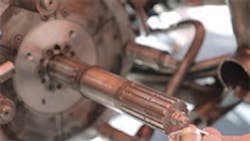Encoders don't crack under pressure
For reasons that can probably go unsaid, delicate optical glass encoders have no business in high-shock applications. A far more appropriate alternative for extreme motion tracking is magnetic rotary encoders. The elegantly simple units consist of two basic parts — magnet and chip. A small, diametrically polarized magnet rotates above an ASIC. The latter contains an array of Hall effect sensors that detects magnetic flux changes and generates a voltage as the magnet rotates above it. It’s a solid-state noncontact unit; robust sealed models even feature “hard hat” metal housings with the ASIC embedded in an epoxy matrix for extra durability.
In fact, rugged magnetic rotary encoders from Renishaw Inc., Hoffman Estates, Ill., have recently been certified by the Federation Internationale de L’Automobile for motorsports, including Formula 1 racing. (An earlier custom version of an RM22 was run by one F1 team in 2007.) The magnetic encoder range is designed and manufactured by Renishaw’s partner, RLS d.o.o, in Ljubljana, Slovenia, for high-resolution positioning (up to 8,192 count per revolution) at speeds to over 30,000 rpm, and measurement accuracies to ±0.5°. Because high temperatures accompany shock in racing, custom-engineered versions of the RM22 magnetic encoder have been homologated for speed and position control at speeds to 60,000 rpm and temperatures to 170°C. The encoders provide by-wire feedback for wheel speed, steering, and gearbox applications.
Besides Formula 1 racing, Europe’s fastest drag racing motorcycle team, Salakazi Racing of Finland, uses Renishaw’s RM22 encoders to monitor crankshaft position and clutch speed. The encoders help upstream controls optimize clutching for perfected motorcycle wheel speed — for acceleration (to speeds in excess of 300 km/hr) when the motorcycles explode off the start line, sans any squealing spin if tires aren’t engaged with the pavement. “I honestly think that only a space rocket would be a tougher environment for the encoder,” says Peti Makinen, Salakazi’s technical chief. Frictionless low-inertia operation also eliminates the need for seals or bearings that can fail under shock. For more information, call (847) 286-9953 or visit www.renishaw.com.
